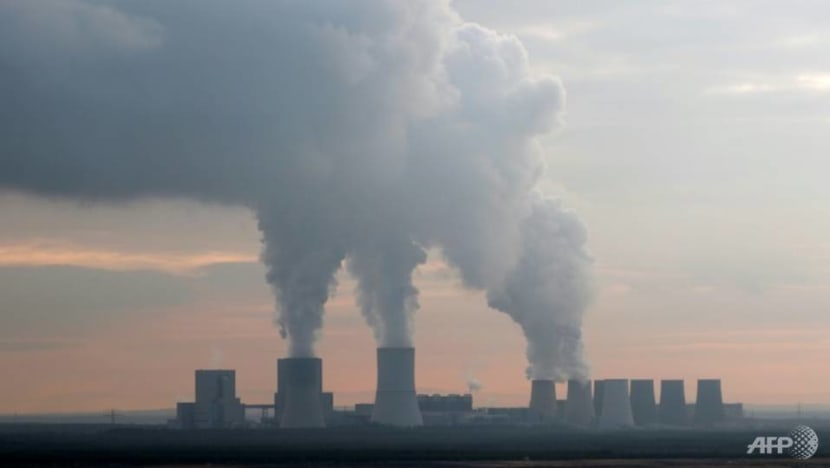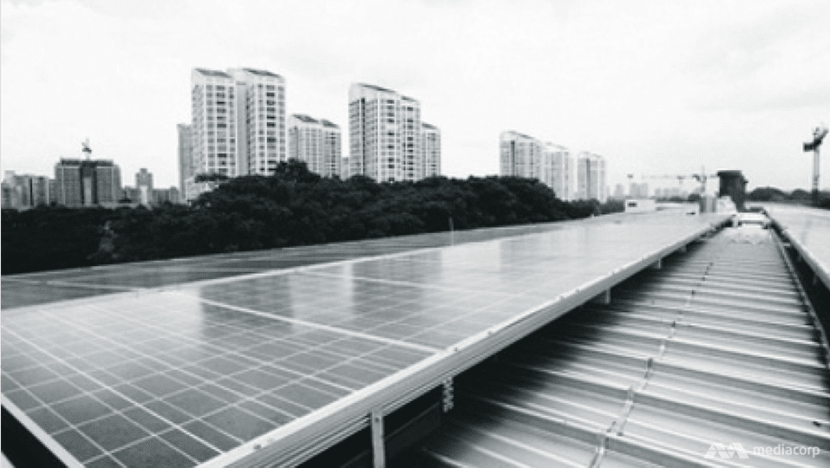Explainer: Mitigation efforts for a world warming by less than 2 degrees

The levels of greenhouse gases in Earth's atmosphere from burning fossil fuels are growing every year. (AFP/Federico Gambarini)
The Paris Agreement 2015 was a landmark in international cooperation in the fight against man-made climate change under the United Nations Framework Convention on Climate Change (UNFCCC).
As of February this year, 189 out of 197 Parties to the Agreement have confirmed their pledges to pursue sustainable development that keeps the world’s average surface temperature from warming more than 2 degrees Celsius above the pre-industrialisation level.
Keeping within the 2-degree warming threshold, climate change would not stop but would slow down substantially, forestalling significant threats posed to human societies in this century by extreme weather events and ecosystem disruptions.
INHERENT CHALLENGE TO MITIGATION
The root cause of man-made climate change lies in the increased emissions of greenhouse gases (GHGs) like carbon dioxide and methane due largely to global energy and food production that accompanies economic growth and rising living standards.
Under the current technological and societal conditions, mitigating climate change via limiting the emission of GHGs challenges the living standards of people around the world and their hopes for further development.
This is why a worldwide agreement to mitigate climate change is a historic moment for a civilisation. Mitigation requires a fundamental transformation in technology and society: to move away from fossil fuels – coal, oil and natural gas – as our primary energy source and to adopt sustainable practices in forestry, agriculture and urban development.
The far-ranging consequences of slowing down climate change requires painful socio-economic adjustments.
The US under the current administration has already backtracked and submitted to UNFCCC its withdrawal from the Paris Agreement in November last year.
However, the required near-term mitigation efforts cannot be compared to the long-term “high to very high risk of severe, widespread and irreversible impacts globally” arising from climate change under the business-as-usual scenario.
The sombre words in quotes came from the Summary for Policymakers in the Synthesis Report of the 5th Assessment Report of the Inter-governmental Panel for Climate Change (IPCC), the international scientific authority supporting the UNFCCC.

FOSSIL FUELS A DOUBLE-EDGED SWORD
Our civilisation is founded on burning large quantities of fossil fuels to power transportation and industrial machinery, to heat buildings in cold climates, to cook food and to generate electricity.
Because of the accessibility to this cheap power source, large-scale mechanisation and electronic automation is possible, having brought more than two centuries of large-scale production and global distribution of goods.
Economic development built upon this energy foundation has lifted societies as small as Singapore and as big as China out of poor living conditions within the last fifty years.
Just as much of Asia, Latin America and Africa are hopping on this train of advancement running on fossil fuels, the world collectively realised that very burning of fossil fuels releases large quantities of carbon dioxide that is causing the Earth’s climate to change.
This unsustainable practice must stop if humanity is to avoid hurting himself by inflicting irreversible damage to the environment that supports his living. Other primary energy sources that do not generate GHGs in their exploitation must take over global energy production. The preferred primary energy sources for the future are mostly the renewable ones like solar, wind, hydroelectric, sustainable biomass and geothermal energies.
Nuclear energy is a non-renewable alternative to fossil fuels that can be a stop-gap measure in the process of global energy transformation as renewable energy production gears up. While it does not have a high carbon footprint, the fission of heavy nuclei like uranium and plutonium is not the long-term solution for humanity’s energy needs because of the difficulty in disposing the radioactive waste produced.

In 2010, the share of the above low- or zero-carbon energies in the global energy production is around 15 per cent.
If this share increases steadily to reach around 30 per cent, 50 per cent and 90 per cent respectively by 2030, 2050 and 2100, IPCC estimates that our warming Earth is more, if not equally, likely to remain within the 2-degree threshold than not.
This estimate is evidently still plagued by uncertainty despite the projected energy transformation.
READ: 2010s hottest decade in history, UN says as emissions rise again
UNCERTAINTIES ON THE PATH
There are many uncertainties in the global socio-economic system that preclude a more precise future projection.
Some of these uncertainties can cause GHG concentrations to rise and the 2-degree threshold to be exceeded even when the world increasingly adopts low- and zero-carbon energies.
One source of uncertainty lies in the use of land for forestry and agriculture. Deforestation every year causes carbon dioxide levels to rise.
As trees grow slowly over hundreds of years, they biochemically fix carbon dioxide in the wood that they form. When forests are cleared for timber and make way for agriculture or urban uses, the biomass of that land area stops increasing on climatic time-scale and this natural sink for carbon dioxide is destroyed.

Another source of uncertainty concerns urban growth. As megacities grow, the development of public transportation networks like trains and buses may not catch up in time.
This leaves most of the population to use cars or motorcycles that have larger carbon footprint per passenger per kilometre.
As the need for international connectivity is enhanced by economic development, air travel for business and holidays also increases. Aircrafts have as high a carbon footprint per passenger-kilometre as luxury cars.
Thus, the preferred choice of transport mode in society makes a real difference between a high or low-carbon future.
COMPLEMENTARITY PRINCIPLE
The transport sector provides a good example of how electrification can greatly boost the agenda of lowering carbon footprint.
Having vehicles that burn petrol directly or run on electricity produced by burning natural gas in power stations are not so different as far as GHG emissions are concerned.

But when societies transition to the use of electric vehicles, generating electricity from renewable or nuclear sources conveniently provides a way to lower the carbon footprint of vehicle transport.
So electric vehicles are a complementary technology to renewable energy production: the growth of one technology facilitates that of the other.
Another complementary technology is renewable hydrogen: when too much electricity is generated by renewable sources, the excess is used to electrolyse water which splits chemically to yield hydrogen and oxygen.
The hydrogen can be stored, transported and consumed as a fuel. It can be traded easily between producers and consumers of renewable energy as a commodity.
The principle of complementarity can be applied beyond the technologies themselves into the realm of policies.
Policies that seed and grow low-carbon technologies in energy production, transportation, manufacturing and construction sectors should be complemented with policies encouraging the diffusion of such technologies among nations, especially from the developed economies to the developing economies.
In addition, policies that support the financing of mitigation measures have a fundamental role in driving the future transformation.
INTEGRATION WITH SOCIO-ECONOMIC OBJECTIVES
For decades, there have been international programmes that aim to encourage technological advancement and economic development in societies to improve living standards.

The transfer of climate-change mitigation technologies, which itself is necessary for a low-carbon global future, is concomitant with these long-standing aims.
For instance, receiving an average daily flux of 6.8 kilowatt-hour of solar energy per square metre, Namibia has tremendous untapped potential to become an energy powerhouse for southern Africa.
The Namibian government is already working with the Global Future Council on Energy under the auspices of World Economic Forum to develop a 5-gigawatt solar power mega-project over the next two decades.
Social development objectives like gender equality should weave into the climate-change mitigation programmes as new career opportunities emerge in technology, finance and policy sectors.
The integration of climate mitigation goals and socio-economic development objectives is necessary to ensure the long-term sustainability of a world warming by less than 2 degrees.
Associate Professor Koh Tieh Yong is a climate scientist at the Singapore University of Social Sciences.














